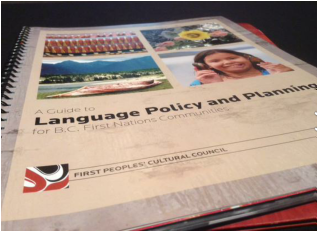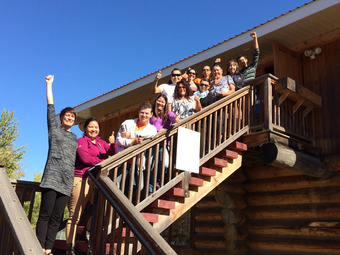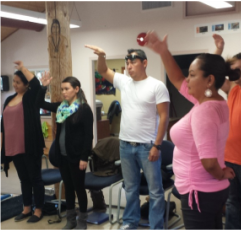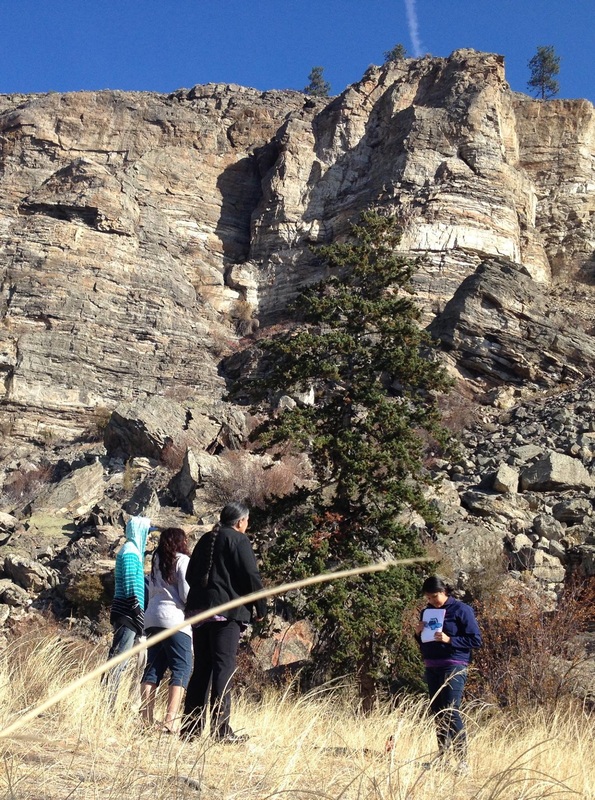|
As learners, we feel like we are making history, each one of us. There is a sense of power in the room, as well as courage, dedication, and commitment. Each of us is committed to stay in the room until we become speakers. We will become a language family. Before we started, it looked like student numbers might be too high—a good problem to have—so we chose the larger classroom space, ordered 20 chairs and printed out 20 textbooks. Our starting numbers were twelve adult students, and five co-teachers. We will be joined by one more student after Nsyilxcn 1 is finished in November, making us thirteen students and five teachers, eighteen in total. My role and responsibility is lead teacher, teacher-trainer, and project coordinator. The co-teachers have each finished the first three to five Paul Creek books, putting us about six months of study ahead of the group. We will stay ahead of the students for the first year by studying at a fast pace. By the next school year, the students will catch up to us and we will all be at the same level. One of my favourite teaching roles in the first day is to make sure that everyone has an Nsyilxcn name. Two students did not, so we brainstormed as a group to come up with fitting names. Krista became “person who smiles” which fits her perfectly. I called Andrew McGinnis to confirm the pronunciation of the names and he was happy to hear we were already in the room studying nqilxwcn. He can’t wait to join us, once we have reached at least a solid beginner level. Our experience in the classroom is overwhelmingly positive. We are supportive, encouraging, enthusiastic, and loving. Our teaching practices embrace the best language acquisition techniques and prioritize classroom safety. Our lessons are in full immersion. Each of us feels the tension of language learning, but it is balanced by a feeling of safety and connection to each other.
X̌astítkʷ Jolene Michel posted a beautiful FaceBook post last week (Oct. 21, 2015): I'm really happy with life these days. I have had the amazing opportunity to attend the language house in Inchelium this past summer. Currently I have transitioned to the Syilx Language House here in Penticton. I'm very hopeful and super excited about the language and where we are going as learners/beginners. I love the continual push to my learning, with this amazing curriculum. I'm also super grateful for the amazing circle of language family I've met. A great expression I've heard recently is "language doesn't die in healthy communities" [April Charlo from Flathead MT]. The thing I must remind myself is to ignore the negativity that is unfortunately associated with language. To me language is meant to be a positive thing, a way to connect us with not only the land but with each other and ourselves. This is our 4th consecutive week holding classes at the Syilx Language House. This was an exciting week for us, not only did the classes go through lessons 19 to 24 in Ńsəĺxcin 1. Which covered topics such as physical description, days of the week, meals, animals and weather.
We also sent a few representatives, Sʔimlaʔxʷ and X̌astitkʷ, of the SLHA (Syilx Language House Association) to attended the Penticton Indian Band’s weekly community meal. Our plan was to reach out to community on how we as the SLHA can be of support, as well as incorporating a little language. The best way we thought to do this was creating a fun lesson card with a few Ńsəĺxcin words from the “meal time and drinks” lessons. We chose words such as deer, chicken, fry bread, coffee, juice, as well as small phrases such as I want, I don't want. We also put together a one page feedback forum, in hopes to gather some ideas on how we can support the community. Lastly, our week ended with our 4 co-teachers reviewing a lesson in Captikʷł 1 and a lesson Ńsəĺxcin 2. This is an exciting week for us for sure, because not only do we have our beginner cohort learning, we also have our co-teachers reviewing and or learning the higher beginner material. There is definitely an is a great amount of language learning going on here, and we are only in our 4th week. Way' Wednesday was a low participation day for our cohort, so instead of having only a couple students stay here at the house, we decided to go for a field trip. We began our drive toward Vaseux Lake, which is between Okanagan Falls and Oliver BC, to where some of our local pictographs are. This day was also exciting, because it was our co-teacher X̌astitkʷ first time ever teaching a lesson. This definitely was a special day to be learning the language, simply because we got to be out on the land. Finally, before it got too cold, we sang a couple traditional songs, and got back into our vehicles and came back to The Language House. Lets not forget to mention that with our little adventure, we still had time to finish up our 3 lessons for the day. Now that definitely calls for another field trip! Nin̓wis łwikn̓tsn (see you later)
 This past weekend we sent two of our co-teachers to The Language Planning Revitalization Workshop, hosted by The First Peoples Cultural Council (FPCC). It was a great opportunity to hear the language work that is going on within different First Nations communities across British Columbia. The great part of this workshop was that it set a lot of time aside for each Nation to have a serious look at where our language is at. We had to work through questions as a planning committee like: what is our mission and vision statements, what are some of the barriers that we are facing, how can we get past theses barriers, and most importantly looking at the beginning stages or our plan for language revitalization. Also the nice thing about this workshop was the chance to network with other First Nations language advocates from across British Columbia. Lastly, the FPCC gave out some very useful templates and resources for us participants to utilize. One of them that was very interesting is called the Endangered Languages Project, so please check this site out, search your particular language, and it also gives you the opportunity to add language resources to the site. Nin̓wis łwikn̓tsn (See you later).  October 7, 2015 Eighteen students are rising to the challenge to revitalize their critically endangered language. “kwu sqilxʷ, kwu sʔaláʔ, uł kwu sqwaʔqwaʔál: we are sqilxw (Okanagan), we are here, and we are beginning to speak,” says Sʔímlaʔxw (pronounced Seemlaw) Michele Johnson, lead teacher of the group. She adds, “our language is deeply connected to who we are and to the health and well-being of our communities.” Johnson launched a bold collaboration between Osoyoos Indian Band, Penticton Indian Band, and Westbank First Nation, leading with the words: kn kł sqiʔs – I have a dream. Nsyilxcn (Okanagan language), like most Indigenous languages, is critically endangered. There are fewer than one-hundred fluent Elders remaining, and no new speakers have been created in Canada in over sixty years. The Syilx Language House Association was formed to reverse this trend, a vision Johnson has been working towards for six years. She began by completing her PhD in language revitalization at UBC-Okanagan, “I decided to take on the challenge of creating ten new speakers. I wanted to learn how to do that.” She found her answers with the Paul Creek curriculum, cleverly designed so beginners can learn while teaching. “We are so lucky to have this; it gives us the opportunity to raise each other up,” she says of the six cutting-edge textbooks co-written in Keremeos by Chris Parkin, LaRae Wiley and Sarah Peterson. When asked if young people really want to learn, Johnson answers, “there are several young people in each community that are passionate about learning language—that are taking it on as a role and responsibility to their communities.” Although most Indigenous languages are critically endangered, people want them back. A quick Google search shows that First Nations language programs across Canada are springing up to reverse language decline. In fact, Syilx community members and Elders stress that language and culture are of paramount importance. “In our Comprehensive Community Plan, language and healing were our top priorities,” says Chief Jonathan Kruger of the Penticton Indian Band. He added, “Chief Clarence Louie challenged all the Chiefs to do more language. Our Council heard Paul Creek was the best model and language houses were having success. We wanted to bring it here. The Chiefs were all talking about it and I said, ‘I’m going to invest in it and build a language house.’” Penticton Indian Band was the first to invest core funding and to provide a classroom location, followed by support from Osoyoos Indian Band and Westbank First Nation. Each Band sponsored employees to attend two days a week for four years and provided core funding. The program has thirteen beginners, five co-teachers (also students), and four Elders from across the Syilx territory, Penticton, Osoyoos, Keremeos, Westbank, Vernon, and the Okanagan Nation Alliance. After four years, Johnson promises intermediate speakers, “It really is the first time we have attempted to create new Nsyilxcn speakers—research shows that it takes 2,000 hours of study to create a high-intermediate speaker.” Over the course of the program, Johnson and her staff will also record Elders, publish language books and CDs, and host open-house community events. Johnson would like to express gratitude to supporters and partners, including Penticton Indian Band, Osoyoos Indian Band, Okanagan Nation Alliance, Okanagan Indian Band, First Peoples Cultural Council, Land Strategies, Columbia Power, and Simon Fraser University. The Association is fundraising for next year’s operating budget and welcomes community visits, donations, and volunteers from community. Further details and contact information are available on the Association’s website: www.thelanguagehouse.ca.  This is an exciting week for everyone, finally after all of the planning, scheduling and arranging , we are very happy to have completed our first week of Nsyilxcn classes. We are all learning each others sn̓qlxʷskʷists (Syilx Names) and us as staff and co-teachers are finally able to put some of the names to the faces of the 12 new language learners. For our first week of learning we have set the pace, we are in class 2 intensive days per week, starting at 9:00 am and ending at 4:00 pm. Each day we are able to cover 3 lessons and a review, we also teach a song every other day. This means in our first week, we have already covered lessons 1 through 6. These topics included introduction, numbers and age, food, physical description, personality traits, and the immediate family. As you can see from the picture posted, the lessons are very interactive, making learning fun, but help with the retaining the words through memory association. We will be posting blogs ever week to show you our progress. Please continue to read and share them with your friends and family. Nin̓wis łwikn̓tsn (See you later) |
Archives
January 2024
Categories
All
|


 RSS Feed
RSS Feed